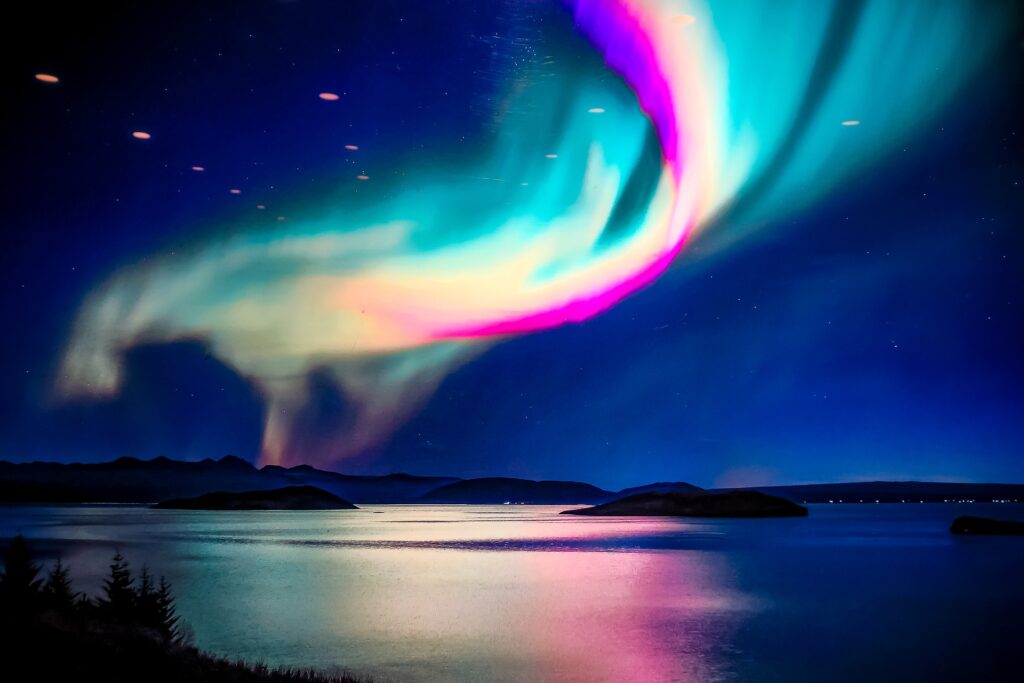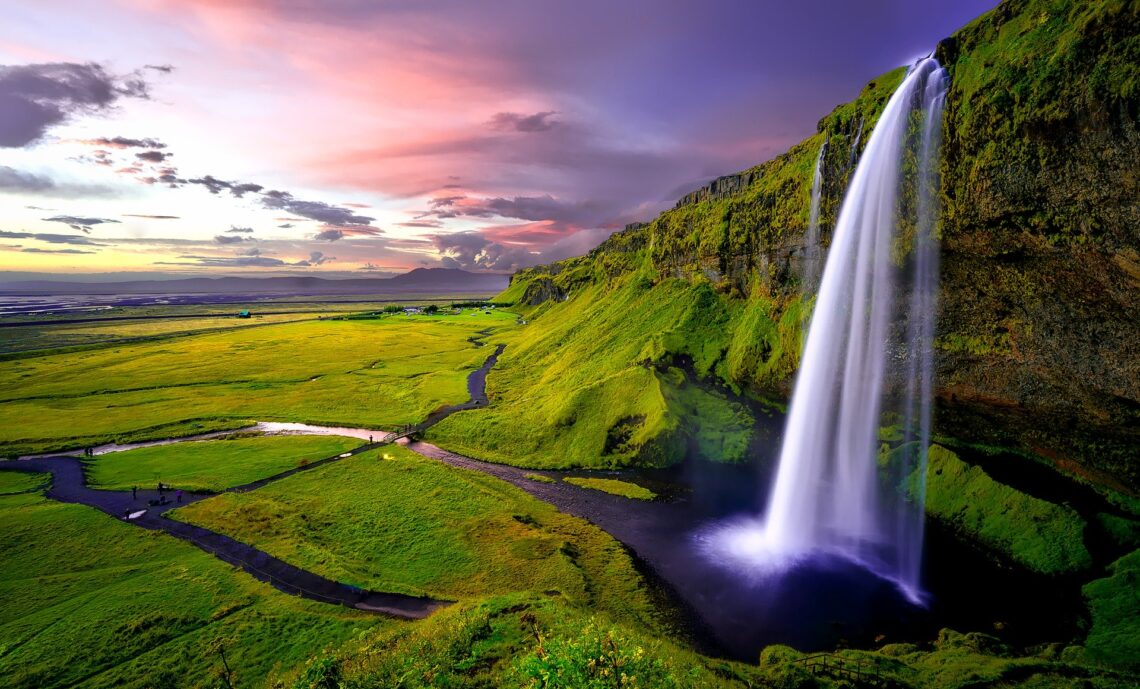Iceland experiences an unpredictable oceanic climate, with frequent changes in temperature and precipitation. A sunny day can quickly turn into a windy, rainy one. Overall, temperatures remain relatively mild; January is the coldest month with frequent snowfall, but extreme cold is rare. Summer is the best season for outdoor activities, with temperatures typically between 10°C and 15°C (sometimes exceeding 20°C), although it never gets truly hot. Wind plays a significant role in Reykjavik’s weather, and strong gusts can make the air feel much colder.
Iceland in Spring (March to May)
In March, temperatures often stay below freezing, but they gradually rise throughout April and May. As the weather warms, you’ll start to see green grass and blooming flowers. Spring offers refreshing weather, normal daylight hours, affordable accommodation, and cheaper airfare, making it a great time to visit.
Recommended Clothing:
Daytime temperatures usually range from 4°C to 10°C, but nights can still dip below freezing. Make sure to pack warm clothes.
March – Transition from Winter to Spring:
March marks the beginning of milder weather. Average temperatures range from 0°C to 4°C, still chilly but with noticeably longer daylight hours (10–12 hours). Alternating snow and rain are common, but there are also many clear days, making it a good time for road trips. The Northern Lights are often visible until the end of March.
April – The Start of Spring:
Although officially spring, April in Iceland still carries traces of winter. Average temperatures range from 1°C to 7°C. Rain becomes more common than snow, and daylight extends to 13–16 hours. While some areas turn greener, highlands and northern regions may still be covered in snow.
May – Approaching Early Summer:
May signals the real arrival of greenery. Average temperatures range from 4°C to 10°C and feel much warmer. Daylight hours extend to an incredible 17–20 hours, creating an almost “Midnight Sun” experience. Iceland’s fields begin to burst with colorful wildflowers from mid-May.
Iceland in Summer (June to August)
Summer is Iceland’s peak tourist season. In June and July, the Midnight Sun means you can experience 24 hours of daylight. Outdoor activities abound, but many theaters and cultural venues temporarily close as locals take their summer holidays.
Recommended Clothing:
Thanks to the Gulf Stream, Iceland remains cool even in summer. Daytime highs usually hover around 12°C to 14°C, and nighttime temperatures can drop to 7°C–8°C. Pack a light jacket and layers.
June – The Beginning of Summer and Midnight Sun:
June officially welcomes summer. Average temperatures range from 8°C to 13°C. Around mid-June, the sun never fully sets, offering a full day of daylight. The weather is generally dry and ideal for hiking, camping, and road trips.
July – The Warmest Month:
July is the warmest month in Iceland. Average temperatures are between 10°C and 15°C, and some days may even top 20°C. With endless daylight, nature reaches its peak vibrancy—waterfalls, glaciers, turquoise rivers, and lush green meadows are at their best.
August – Late Summer Richness:
August is the last month of summer, with temperatures between 8°C and 14°C. Daylight hours slowly decrease but remain generous at over 16 hours per day. Wild blueberries and other berries ripen, and light morning frosts may appear late in the month. By the end of August, the Northern Lights start to make their return.

Iceland in Fall (September to November)
Fall brings rapid weather changes as warm air from the Gulf Stream meets cold Arctic air, leading to sudden rain, wind, and dramatic temperature shifts. You might experience all four seasons in a single day! After the peak season ends in September, many museums outside Reykjavik close until next summer. October through December is considered the rainy season, with more indoor cultural activities becoming available.
Recommended Clothing:
Prepare for highly variable weather. Waterproof jackets, boots, and layers are essential.
September – Start of Fall and Aurora Season:
September marks the true beginning of autumn. Average temperatures range from 5°C to 10°C, with an increase in rainy days. The landscape transforms into vivid reds and oranges, and the nights are dark enough once again to spot the Northern Lights. Crowds are smaller compared to summer but still lively.
October – Deepening Autumn:
October sees noticeably colder temperatures, with averages between 2°C and 7°C. Rain is frequent, and the first snowfalls often arrive. Daylight hours shorten to about 8–10 hours. This is one of the best times for calm, peaceful landscapes and Northern Lights hunting.
November – On the Edge of Winter:
By November, average temperatures drop to between -1°C and 4°C, and snowfall becomes more common. Icy road conditions are frequent. Daylight shrinks dramatically to about 5–6 hours per day. The Northern Lights continue to be visible, but travelers should exercise caution when driving.
Iceland in Winter (December to February)
Thanks to the Gulf Stream, Iceland’s winters are milder than in other regions at similar latitudes. Average lows stay around -2°C. During mid-winter, polar nights occur, with minimal daylight hours—making it an excellent season for Northern Lights viewing. Winter also sees fewer tourists, making flights and accommodations more affordable, except during Christmas and New Year holidays when the island becomes busier.
Recommended Clothing:
Dress warmly in layers, with heavy coats, insulated boots, gloves, and hats essential for staying comfortable.
December – Peak of the Dark Winter:
December is the darkest month, with average temperatures between -1°C and 4°C. There’s only about 4–5 hours of daylight. Iceland glows with festive Christmas lights, creating a magical atmosphere. It’s also a prime time for experiencing winter festivals and traditional Icelandic culture.
January – Deep Winter:
January is the heart of Icelandic winter. Average temperatures hover between -1°C and 3°C. Although it’s not extremely cold, strong winds can make it feel much colder. Daylight is still limited to about 4–5 hours per day. Snow, rain, and frequent Northern Lights sightings characterize the month.
February – Winter Continues, Longer Days Begin:
February remains cold, with temperatures between -1°C and 3°C. Snowstorms and strong winds are common. However, daylight gradually increases to about 7 hours per day. The Northern Lights are still easily visible, and February is a great time for winter adventures like ice cave tours.
Best Time to Visit Iceland
Reykjavik’s peak season runs from June to August, when the weather is most favorable. However, this is also when prices for accommodation and flights are at their highest. If you prefer a quieter and more affordable vacation, May and September are excellent alternatives—offering pleasant weather and fewer tourists.
| Month | Avg High (°C) | Avg Low (°C) | Rainfall (mm) | Snowfall (cm) |
| January | 3.1 | -1.8 | 83.0 | 19.9 |
| February | 3.3 | -1.9 | 85.9 | 17.1 |
| March | 4.0 | -1.3 | 81.4 | 23.2 |
| April | 6.8 | 1.2 | 56.0 | 12.1 |
| May | 9.8 | 3.9 | 52.8 | 1.6 |
| June | 12.7 | 7.7 | 43.8 | – |
| July | 14.6 | 8.8 | 52.3 | – |
| August | 13.9 | 8.7 | 67.3 | – |
| September | 11.1 | 5.9 | 73.5 | – |
| October | 7.5 | 2.7 | 74.4 | 1.4 |
| November | 4.5 | -0.2 | 78.8 | 8.7 |
| December | 3.3 | -1.6 | 94.1 | 17.8 |




